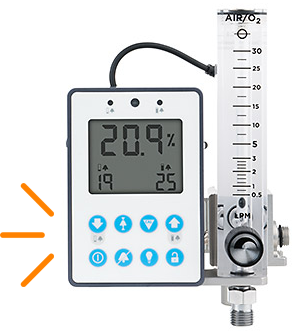
How much can you save?
Use the calculator below to see how much your facility might save in the cost of wasted gas by using the MaxBlend Lite compared to using industry-standard blenders.

FAQs
Air-oxygen blenders used in respiratory care “bleed” gas in an effort to maintain FiO2 prescription accuracy when delivering low flows. As long as a blender is connected to oxygen and air gas sources, it will bleed when idle and when in use on a patient.
With low flow blenders, this bleed rate can be as high as 3 LPM.
Example:
A clinician is delivering 4 LPM of FiO2 to a patient with a low flow blender. During this time, an additional 1 LPM of blended gas might be lost to gas bleed. When the patient is done being treated and they are no longer connected to the oxygen delivery set-up, the blender will continue to bleed gas at a rate of up to 1 LPM (assuming oxygen and air gas sources stay connected to the blender). This means there is a gas bleed even when the blender is not in use.
Gas bleed is required for all blenders (not just Maxtec blenders) and is necessary in order to achieve the pressure balance needed for the proportional valve to accurately mix the gases. A gas bleed is required for flows below 3 LPM on a low flow blender and below 15 LPM on a high flow blender.
Medical oxygen can be expensive. Any time blenders bleed, a portion of gas might be wasted and this cost can add up over time.
Even though gas bleed is necessary to maintain accuracy when delivering low flows during oxygen delivery, Maxtec wanted to find a way to better manage this gas bleed to avoid wasting gas when possible.
This is why a gas bleed savings mechanism was incorporated into the design of the MaxBlend Lite – to save healthcare facilities money and resources from wasted oxygen.
When using a low flow (0-3 LPM, 0-15 LPM, or 0-30 LPM) MaxBlend Lite:
- Bleed control switch should be switched to <3 LPM when delivering flows less than 3 LPM and when blender is not in use.
- Bleed control switch should be switched to >3 LPM when delivering flows greater than 3 LPM.
When using a high flow (0-70 LPM) MaxBlend Lite:
- Bleed control switch should be switched to <15 LPM when delivering flows less than 15 LPM and when blender is not in use.
- Bleed control switch should be switched to >15 LPM when delivering flows greater than 15 LPM.
If a clinician does not use the gas bleed in the way it is intended as recommended above, there is no concern about patient care being disrupted. The MaxBlend Lite monitor will remain accurate regardless of gas bleed switch settings (as long as it is calibrated correctly).